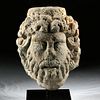Over-Lifesize Roman Basalt Head of Serapis
Lot 38
About Seller
Artemis Gallery
686 S Taylor Ave, Ste 106
Louisville, CO 80027
United States
Selling antiquities, ancient and ethnographic art online since 1993, Artemis Gallery specializes in Classical Antiquities (Egyptian, Greek, Roman, Near Eastern), Asian, Pre-Columbian, African / Tribal / Oceanographic art. Our extensive inventory includes pottery, stone, metal, wood, glass and textil...Read more
Categories
Estimate:
$8,000 - $12,000
Absentee vs Live bid
Two ways to bid:
- Leave a max absentee bid and the platform will bid on your behalf up to your maximum bid during the live auction.
- Bid live during the auction and your bids will be submitted real-time to the auctioneer.
Bid Increments
| Price | Bid Increment |
|---|---|
| $0 | $25 |
| $300 | $50 |
| $1,000 | $100 |
| $2,000 | $250 |
| $5,000 | $500 |
| $10,000 | $1,000 |
| $20,000 | $2,500 |
| $50,000 | $5,000 |
| $100,000 | $10,000 |
| $200,000 | $20,000 |
About Auction
By Artemis Gallery
Dec 2, 2021
Set Reminder
2021-12-02 10:00:00
2021-12-02 10:00:00
America/New_York
Bidsquare
Bidsquare : Fine Antiquities | Asian | Ethnographic Art
https://www.bidsquare.com/auctions/artemis-gallery/fine-antiquities-asian-ethnographic-art-7918
Features classical antiquities, ancient and ethnographic art from cultures encompassing the globe. Egyptian, Greek, Roman, Etruscan, Near Eastern, Asian, Pre-Columbian, Native American, African / Tribal, Oceanic, Spanish Colonial, Russian, Fine / Visual Arts, so much more! Artemis Gallery info@artemisgallery.com
Features classical antiquities, ancient and ethnographic art from cultures encompassing the globe. Egyptian, Greek, Roman, Etruscan, Near Eastern, Asian, Pre-Columbian, Native American, African / Tribal, Oceanic, Spanish Colonial, Russian, Fine / Visual Arts, so much more! Artemis Gallery info@artemisgallery.com
- Lot Description
**This is an oversized piece that may require special shipping. Please inquire for a quote prior to bidding.
Roman, Imperial Period, ca. 1st to 3rd century CE. A finely sculpted basalt head of Serapis wearing a modius crown. Serapis, god of fertility and the afterlife, was a Graeco-Egyptian god who first appeared around the time of Alexander the Great and later adopted into Roman religion. Presented here with a full beard and mustache as well as an expressive visage framed by thick, wavy locks. Serapis is a combination of the attributes of the Egyptian god Osorapis (himself a composite of Osiris and Apis) with the attributes of several Greek gods including Zeus, Hades, Helios, and Dionysus. Ancient Romans did not typically respect the deities and belief systems of other ancient cultures, however those in the Greek and Egyptian pantheons were revered. Size: 15.5" H (39.4 cm); 22" H (55.9 cm) on included custom stand.
The god Serapis was originally created by Ptolemy I of Egypt as a means of unifying the Grecian and Egyptian cultures around the 3rd century BCE, though Romans were quick to adopt the cult of Serapis in favor of other overarching deities such as Osiris around the 4th century CE. From the late Hellenistic through to the Roman period, the cult of Serapis increased in importance, and his image was disseminated throughout the ancient world of the Mediterranean. Perhaps this example was modeled upon the Serapis of Bryaxis, created by the Greek sculptor in the 4th or 3rd century BCE for the Serapeum at Alexandria. This prototype inspired centuries of art, in which the god was represented seated, a sceptre in his left hand, his right hand resting on a figure of Cerberus, and wearing a chiton and himation, with a modius - a flat-topped crown so named because of its resemblance to a jar used as a type of grain measure - atop his head.
This piece has been searched against the Art Loss Register database and has been cleared. The Art Loss Register maintains the world's largest database of stolen art, collectibles, and antiques.
Provenance: East Coast collection, New York Gallery, New York City, New York, USA, before 2010; ex-Frances Artuner collection, Belgium, acquired in the 1960s
All items legal to buy/sell under U.S. Statute covering cultural patrimony Code 2600, CHAPTER 14, and are guaranteed to be as described or your money back.
A Certificate of Authenticity will accompany all winning bids.
PLEASE NOTE: Due to recent increases of shipments being seized by Australian & German customs (even for items with pre-UNESCO provenance), we will no longer ship most antiquities and ancient Chinese art to Australia & Germany. For categories of items that are acceptable to ship to Australia or Germany, please contact us directly or work with your local customs brokerage most antiquities and ancient Chinese art to Australia & Germany. For categories of items that are acceptable to ship to Australia or Germany, please contact us directly or work with your local customs brokerage replace this
#142464Expected surface wear commensurate with age. Loss to parts of modius crown and some losses to peripheries and high-pointed areas such as nose, mustache, and locks of hair. Still a very strong presence.Condition
- Shipping Info
-
All shipping is handled in-house for your convenience. Your invoice from Artemis Gallery will include shipping calculation instructions. If in doubt, please inquire BEFORE bidding for estimated shipping costs for individual items.
-
- Buyer's Premium



 EUR
EUR CAD
CAD AUD
AUD GBP
GBP MXN
MXN HKD
HKD CNY
CNY MYR
MYR SEK
SEK SGD
SGD CHF
CHF THB
THB















